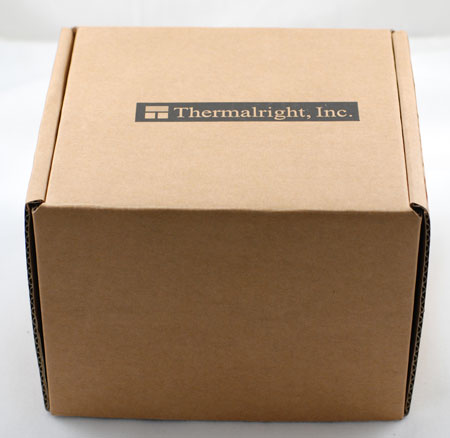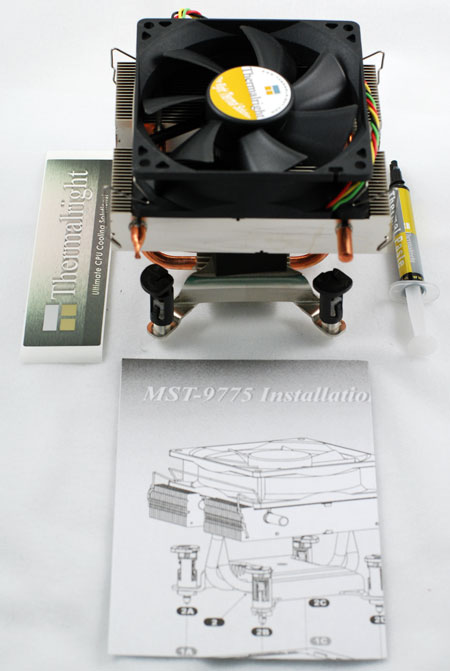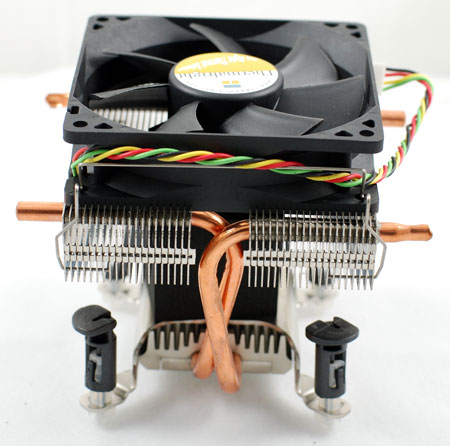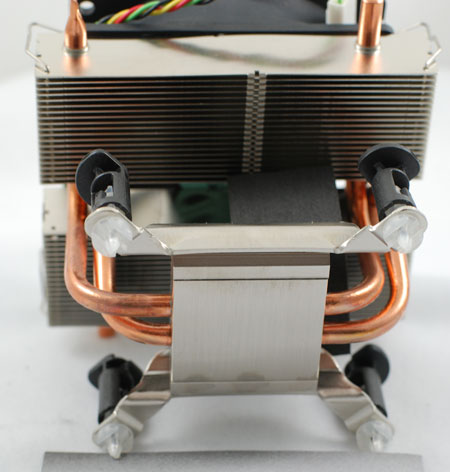Value Cooling: Two Towers for under $30
by Wesley Fink on January 23, 2007 3:50 AM EST- Posted in
- Cases/Cooling/PSUs
Thermalright MST-9775
Most hobbyists first heard of Thermalright when their SK-6 cooler appeared in the summer of 2001 and started winning most of the heatsink roundups. Since then Thermalright has become a well-respected name in high-end air cooling. Thermalright emphasizes their design capabilities in the cooling market, and their advanced manufacturing processes that are ISO-9000 certified.
Thermalright also produced several well-known heatsinks for the AMD K8 and Pentium 4 sockets, such as the legendary XP-120 and XP-90 heatsinks. You bought the Thermalright heatsink and paired it with the 120mm or 90mm fan of your choice - for low noise or massive air flow or some combination that met your needs.
The MST-9775 is a new Thermalright product and a bit of a departure from what you might expect. First of all the unit is a complete cooling solution - including the fan. Second the price tag is a very reasonable $25. While Thermalright has a reputation for delivering great value, their prices have rarely been in the price range of the MST-9775.

Thermalright has never cared much about glitzy packaging. All the Thermalright coolers we have seen are shipped in sturdy natural cardboard boxes.

Inside the plain brown box you will find everything you need to mount the 9775. It is important to understand the 9775 is an Intel-only cooler. This allows Thermalright to use the easy mounting push posts used on the stock Intel cooler. Over time the Intel push posts wear and become more difficult to use, but there is no denying that the mounting is generally very simple and fast. Thermalright even includes a syringe with Thermalright thermal compound in the kit.

The 9775 comes standard with a 92mm fan, which is larger than Intel's stock 80mm. This allows the fan to turn more slowly to produce the same air volume as an 80mm, or the extra size can be used to increase air volume and cooling.

Thermalright also uses a 4-pin fan connector, just like Intel does. That means pin 4 can be used to dynamically control fan speed. While the 9775 fan operates just fine, you can also substitute another 92mm fan if you choose, just like on more expensive Thermalright heatsinks. The fan attaches with typical Thermalright wire clips.
Most hobbyists first heard of Thermalright when their SK-6 cooler appeared in the summer of 2001 and started winning most of the heatsink roundups. Since then Thermalright has become a well-respected name in high-end air cooling. Thermalright emphasizes their design capabilities in the cooling market, and their advanced manufacturing processes that are ISO-9000 certified.
Thermalright also produced several well-known heatsinks for the AMD K8 and Pentium 4 sockets, such as the legendary XP-120 and XP-90 heatsinks. You bought the Thermalright heatsink and paired it with the 120mm or 90mm fan of your choice - for low noise or massive air flow or some combination that met your needs.
The MST-9775 is a new Thermalright product and a bit of a departure from what you might expect. First of all the unit is a complete cooling solution - including the fan. Second the price tag is a very reasonable $25. While Thermalright has a reputation for delivering great value, their prices have rarely been in the price range of the MST-9775.

Thermalright has never cared much about glitzy packaging. All the Thermalright coolers we have seen are shipped in sturdy natural cardboard boxes.

Inside the plain brown box you will find everything you need to mount the 9775. It is important to understand the 9775 is an Intel-only cooler. This allows Thermalright to use the easy mounting push posts used on the stock Intel cooler. Over time the Intel push posts wear and become more difficult to use, but there is no denying that the mounting is generally very simple and fast. Thermalright even includes a syringe with Thermalright thermal compound in the kit.

The 9775 comes standard with a 92mm fan, which is larger than Intel's stock 80mm. This allows the fan to turn more slowly to produce the same air volume as an 80mm, or the extra size can be used to increase air volume and cooling.

Thermalright also uses a 4-pin fan connector, just like Intel does. That means pin 4 can be used to dynamically control fan speed. While the 9775 fan operates just fine, you can also substitute another 92mm fan if you choose, just like on more expensive Thermalright heatsinks. The fan attaches with typical Thermalright wire clips.










28 Comments
View All Comments
takumsawsherman - Wednesday, January 24, 2007 - link
Why is the Tuniq tower 120 being compared against much cheaper coolers with smaller fans? Why not pit it against the Thermalright HR-01, which would be more of an apples to apples comparison?I am sure that Scythe must have a more worthy competitor as well, though I am not familiar with their line.
LoneWolf15 - Thursday, January 25, 2007 - link
Scythe's Infinity is probably the closest competitor. I believe there may be a few other sites that have reviewed it.
Wesley Fink - Wednesday, January 24, 2007 - link
You neglected to mention that we also compared the performance of the Scythe Katana and Thermalright MST-9775 to the Intel Retail HSF that comes with the Core 2 Duo processor. Until we test a cooler that might perform better than the Tuniq the range of performance is "real-world" between the Intel Retail HSF and the Tuniq. We believe most readers want to know how a tested cooler compares in this rnage - so they can decide if the features or cost are worth the performance drop from the best we have tested.In the future we will be testing some new tower coolers that should challenge the Tuniq. We also plan a value cooler roundup of coolers under $30.
Zoomer - Wednesday, January 24, 2007 - link
Seconded!I'm looking forward to seeing the Arctic Cooler 7 Pro review. In cooler climates with a core2 duo, there is really no need to spend the extra $30 for a huge tower heatsink.
Calin - Wednesday, January 24, 2007 - link
The comparison was between the baseline (the included cooler) and the best air cooler there is (at least known/proven until now).Should the Tuniq Tower be compared to the best air cooled equipments out there? Yes, and it would be nice to compare it to a not very expensive water cooled system too.
Jodiuh - Wednesday, January 24, 2007 - link
Well if that's not reason enough to get a Tuniq.LoneWolf15 - Wednesday, January 24, 2007 - link
Getting one dropped my temps from my old Swiftech by 5-8C when idle and 8-15C under load.It sure was a good enough reason for me. And that's with the fan at a quiet 1400rpm.
And I agree (with what I think you're saying) that, if you're going to spend $30 for an aftermarket cooler, and the Tuniq will fit, why not spend an extra 20-25 for best aftermarket cooler you can get?
Avalon - Tuesday, January 23, 2007 - link
I think it's a good addition to AT to include cooling reviews. However, you guys should see if you can expand temperature gauging a little more to also include PWM temps and other important temperatures, as some HSF solutions have a large affect on these, while others don't.Also, really want to see the Coolermaster Hyper TX in the next roundup!
Vidmar - Tuesday, January 23, 2007 - link
What was the orientation of the CPU/heatsink during the tests? Was the case (and MB) in a horizontal or vertical orientation? Since these new coolers use heatpipes and since the heatpipe technology relies on a liquid that turns to gas when heated then back to liquid when cool, the orientation of the heatsink/heatpipe plays a huge role in how the well it will perform.I would like to think that you are running these tests with the case in a vertical orientation like what a large portion of your readers would be using. But since you never say we don’t know. If these tests are being conducted with the case in a horizontal orientation (laying flat on a table), I would expect that the results would be different than what people would get at home (mostly vertical).
Thanks!
Wesley Fink - Tuesday, January 23, 2007 - link
Noise measurements were run with the case horizontal and an open side. Cooling tests were run with the case in the standard upright position, as our readers will most likely use them at home.